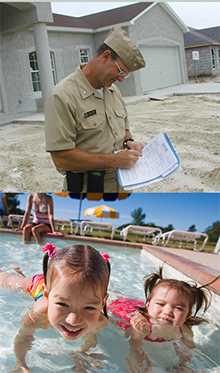CDC's Core Environmental Health Services
CDC 24/7: Saving Lives. Protecting People from Health Threats. Saving Money through Prevention.
Environmental Health
Your environment is everything around you — the air you breathe, the water you drink, the community you live in, the places where your food is grown or prepared, your workplace, and your home. When your environment is safe and healthy, you are more likely to stay healthy. But when your environment exposes you to hazardous substances or dangerous events, your health can be negatively affected.
CDC is committed to saving lives and protecting people from unsafe exposures by responding to natural and man-made disasters, supporting state and local public health programs, educating communities, and providing scientific knowledge. We help maintain and improve the health of Americans by promoting a healthy environment and preventing premature death and avoidable illness caused by environmental and related factors. We also identify how people might be exposed to hazardous substances in the environment and assess exposures to determine if they are hazardous to human health. CDC invests in prevention to improve health and save money by reducing health care costs. We remain committed to maximizing the impact of every dollar entrusted to the agency.

Core Environmental Health Services
Did you take a shower, drink a glass of water, eat at a restaurant, or go for a swim today? Part of the reason we can engage in these everyday activities without worrying about getting sick is that environmental health professionals in our communities work behind the scenes to keep these activities safe.
In the United States, state, local, tribal and territorial environmental health practitioners make sure our water and food stay safe. They prevent outbreaks through permitting and inspection programs for drinking water and wastewater systems, restaurants, school cafeterias, swimming pools, and other facilities.
Environmental health practitioners also investigate outbreaks to identify their environmental causes. They often are activated during emergency responses to perform crucial functions such as assessing shelters and food establishments, testing drinking water supplies, and controlling disease-carrying organisms (vectors). CDC provides practice-based research, training, technical assistance, and evidence-based guidance for these frontline workers.
Environmental Health Specialists Network (EHS-Net): A CDC-led collaboration of federal, state, and local partners, EHS-Net conducts practice-based research to identify environmental causes of foodborne and waterborne illness outbreaks. Through the National Voluntary Environmental Assessment Information System, CDC tracks information from environmental assessments conducted during outbreak investigations.
Training: CDC offers practical, relevant training for environmental health professionals.
E-Learning on Environmental Assessment of Foodborne Illness Outbreaks provides a virtual food service environment to help professionals assess environmental health contributors to foodborne illness outbreaks and standardize environmental assessments.
Environmental Public Health Online Courses provide free training for professionals to study for national credentialing exams or to improve their technical knowledge in the field.
Environmental Health Training in Emergency Response helps practitioners apply environmental health expertise to emergencies.
Vector Control for Environmental Health Professionals emphasizes the use of integrated pest management to address public health pests and vectors that spread pathogens, including Zika virus and others.
Technical Assistance: At the request of states, localities, tribes, and territories, CDC provides assistance to address environmental components of outbreaks and emergencies.
Evidence-Based Guidance: CDC environmental health services staff develops practical, evidence-based guidance on important environmental health issues.
Public Health in ActionSafer, healthier food and control of infectious diseases with clean water and sanitation are among the top U.S. public health achievements of the 20th century. Countries without these systems see higher rates of death, particularly among children. CDC’s environmental health services staff works to protect these important advancements through practice-based research, technical assistance, training, and evidence-based guidance. Following is a sample of recent success stories related to these functions: EHS-Net. A study from an EHS-Net state contributed to a finding by the Food and Drug Administration to amend its Food Code to include a ban on the sale of undercooked ground beef in children’s menus. CDC and collaborators have completed several studies on environmental factors contributing to foodborne illness outbreaks. In addition to this research, EHS-Net created simple, easy-to-understand fact sheets to help busy environmental health and food safety professionals easily access findings and recommendations from those studies. This information can help them promote food safety and prevent outbreaks. Training. CDC’s Environmental Health Training in Emergency Response has armed thousands of environmental health professionals with the knowledge and tools—such as shelter assessment forms—needed to effectively protect public health in the aftermath of disasters. In several instances, disasters struck shortly after students completed the training, and they were able to respond effectively by working collaboratively with local partners, conducting assessments and food safety inspections, testing drinking water supplies, and controlling disease-causing vectors. Technical Assistance. In 2012, CDC worked with tribal communities to control Rocky Mountain spotted fever after the vectorborne disease outbreak killed 18 people. CDC helped develop and implement a reservation-wide dog collaring program to halt disease spread by dogs, the main source of exposure to disease-transmitting ticks. This and other prevention measures have dramatically reduced the risk of additional cases in reservation communities. CDC also contributes environmental health expertise to foodborne and waterborne illness outbreaks. Examples include technical assistance in the Salmonella outbreak associated with peanut butter and in response to the 2010 cholera outbreak that followed the earthquake in Haiti. Evidence-Based Guidance. CDC is collaborating with public health and industry experts to develop the Model Aquatic Health Code (MAHC). The MAHC would provide evidencebased standards to help state and local public health programs reduce risk for waterborne illness outbreaks and drowning, as well as chemical and other injuries at pools, waterparks, and other aquatic venues within their jurisdictions. CDC also has provided environmental health expertise to organizations creating food policy. Additionally, CDC has developed tools such as a boil-water advisory toolkit and a guide for hospitals on ensuring water supply during an emergency for state, local, and tribal partners. |

|
- Page last reviewed: February 26, 2013
- Page last updated: January 10, 2017
- Content source:


 ShareCompartir
ShareCompartir